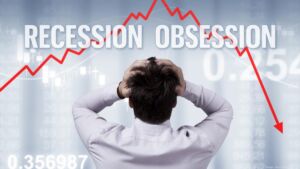Defensive sectors not overextended if macro backdrop remains volatile: DataTrek’s Colas
Recession fears are on the rise as the Federal Reserve gears up to fight inflation. Many stock-market investors are already playing defense and may wonder if those strategies have more room to run.
But first, how big of a worry is a recession? Google searches for the term have been solidly on the rise, according to trend data from the search giant charted below:

The fear is understandable. While the job market remains robust, inflation running at a four-decade high has consumers down in the dumps, according to sentiment readings.
Fed playing catchup
The Federal Reserve is seen belatedly scrambling to tighten monetary policy at a breakneck pace — including the potential for multiple, outsize half-percentage point increases in interest rates. It’s also contemplating a much faster wind-down of its balance sheet than in 2017-2019.
Fed officials, of course, say they’re confident they can tighten policy and bring down inflation without crashing the economy, achieving what economists refer to as a “soft landing.” There are prominent skeptics, including former Treasury Secretary Larry Summers, whose early warnings of surging inflation proved prescient.
Eyes on the curve
And then there’s the yield curve.
The yield on the 2-year Treasury note TMUBMUSD02Y, 2.451% briefly traded above the yield on the 10-year Treasury note TMUBMUSD10Y, 2.829% earlier this month. A more prolonged inverting of that measure of the curve is seen as a reliable recession indicator, though other measures that have proven even more reliable have yet to flirt with inversion.
The yield curve, even when it does flash code red, isn’t much of a timing indicator for stocks, analysts have emphasized, noting that the period between the onset of a recession, as well as a market peak, can run a year or more. Nevertheless, its behavior is getting attention.
Stocks, meanwhile, stumbled in the past week, which was shortened to four days by Good Friday, as the 10-year Treasury yield rose to its highest since December 2018, Russia’s brutal invasion of Ukraine continued and big banks got earnings season off to a mixed start.
The Dow Jones Industrial Average DJIA fell 0.8%, the S&P 500 SPX shed 2.1% and the Nasdaq Composite COMP, heavily weighted to rate-sensitive tech and other growth stocks, slumped 2.6%.
Getting defensive
While only time will tell whether a recession is in the offing, stock-market sectors that perform best when economic uncertainty is on the rise have already significantly outperformed the broader market.
“During periods of macro uncertainty, some companies/industries outperform simply because they have less risky businesses than the average S&P company,” said Nicholas Colas, co-founder of DataTrek Research, in an April 14 note. U.S. large-cap utilities, consumer staples, and health care — often described as the primary defensive sectors — are all outperforming the S&P 500 SPX, -1.21% this year and over the last 12 months.
The S&P 500 was down 7.8% year-to-date through Thursday, while the utility sector was up 6.3%, staples were up 2.5% and health care was down 1.7%.
Colas dived deeper to examine whether those sectors were outperforming by a normal amount for this part of a market cycle. He looked at 21 years of annualized relative return data for each sector, a measure of how each group performed versus the S&P 500 over the prior 253 trading days.
The results:
- Utilities saw an average annualized relative performance versus the S&P 500 from 2002 to the present of minus 2.8%. The 9.9 percentage point outperformance over the last 12 months through Wednesday, was just over one standard deviation from the long-run mean.
- Staples saw an average annualized performance of minus 2.2% versus the S&P 500 over the last 21 years. The 7.6 percentage point outperformance over the last 12 months was just less than one standard deviation from the long-run mean.
- Health care saw an average annualized outperformance of 0.7% versus the S&P 500 over the long run, while the last 12 months of outperformance (10.7%) was just over one standard deviation from the long-run mean.
Room to run?
Such robust numbers could understandably give the impression those sectors may be done outperforming, Colas said. But, in fact, their outperformance has been even stronger during past periods of macro uncertainty, with all three outperforming the S&P 500 by 15 to 20 percentage points.
“Unless you are very bullish on the U.S./global economy and corporate earnings, we suggest you consider overweighting these defensive groups,” he wrote. “Yes, they have all worked, but they are not yet overextended if the U.S./global macro backdrop remains volatile.”

